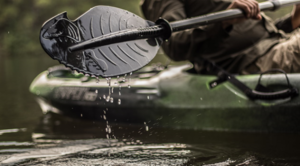Tips for More Efficient Kayak Paddling
from The Fishing Wire

Tips for More Efficient Kayak Paddling
Whether kayak fishing or out for a quiet day on the water, proper and efficient kayak paddling will help increase speed and momentum so you can travel farther with less fatigue. YakGear provides a few general tips for new and seasoned paddlers to make the most of their day on the water.
Proper Posture
Efficient paddling begins with proper sitting posture. An upright sitting position is key to getting the most from your paddle blades and allows for easier dipping and removal of the blade from the water. Paddlers should be sitting upright or slightly forward and not lean on the backrest. Feet should be anchored to the footrests or foot molds with knees slightly bent.
Proper Hand Grip
To determine the optimal grip placement, position the middle of the paddle on your head and grab the shaft with elbows at 90 degrees. This will be the ideal gripping spot for each hand. Most paddlers will tend to over grip the paddle. A light grip will prevent hands from growing tired and give you a better feeling for the balance of the paddle. Using paddle grips, such as HOLDFast Kayak Paddle Grips, will help keep hands fresh and provide a consistent, tactile point of contact.
Paddle Stroke
A smooth and consistent paddle stroke is perhaps the most important aspect of efficient paddling. Most new paddlers hold the paddle too close to their bodies with their elbows bent – more commonly known as paddle hugging. Instead, keep the paddle as far in front of your chest as possible, with elbows slightly bent. This will allow you to reach farther forward when you begin your stroke.
Begin the stroke by reaching forward and inserting the blade into the water, vertically in line with your feet or ankles. If the stroke is on the right side, the right hand serves as a fulcrum point while the left hand pushes forward while your torso rotates to the right. The blade should come out of the water as it passes the hip. Keeping the blade in after the hip does not help propel but actually creates drag. Leaving the blade in the water past your hip also promotes the paddle blade to spoon or bring up water, which will drip down the shaft when that blade is up and out.
Using the Correct Length of Paddle
The general rule of thumb for finding the correct length of paddle is to stand straight and position the paddle vertically alongside your body. If you can reach up and just hook your first finger joint over the blade, it will be the correct length. For kayaks wider than 30 inches, you will need to add those extra inches to the overall paddle length. Paddles are measured in centimeters instead of inches, so a conversion will be needed. One inch equals 2.54 centimeters. For most kayaks and adults, a 230 cm or 240 cm paddle will do the trick.
For kayakers that straddle standard paddle lengths or may have several different sizes of kayaks, the Backwater Assassin Carbon Fiber Hybrid Paddle provides added versatility with an extra 10 centimeters of adjustment to fill the gap. The kayak paddle is available in lengths of 230-240 cm and 250-260 cm.
Efficient paddling is achieved through extensive practice. Spending time on the water in a kayak is quality time that is best shared with family or friends. YakRule No. 15 says it all – “Never Go it Alone.”
See the latest kayaking products and get more tips at www.yakgear.com.